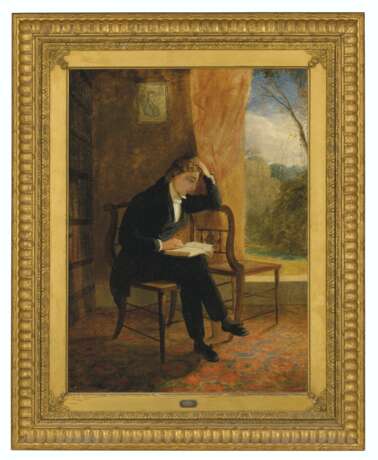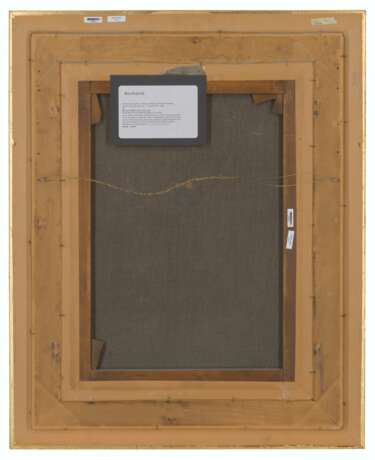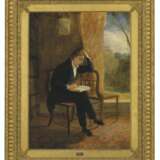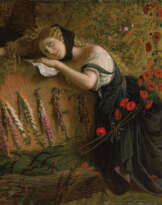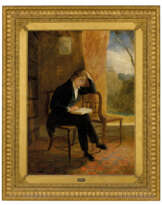ID 519301
Los 12 | Joseph Severn (1793-1872)
Schätzwert
£ 20 000 – 30 000
Portrait of John Keats at Wentworth Place on the day of his composing 'Ode to a Nightingale'
Oil on canvas, 231/2 x 171/2 in. (59.7 x 44.5 cm). Signed and dated 'Severn/1834' (on the bookcase, lower left).
The frame contains a lock of Keats's hair in a small window.
One of the most celebrated images of Keats, painted by the friend in whose arms he died, framed with a lock of his hair. This is a second and subtly altered version ('with some important changes such as the open eye & raised up from the book') of Severn's famous posthumous portrait of his friend, based in part on Keats's death mask, which is now at the National Portrait Gallery (NPG 58). The first version was executed in 1821-23, in the years immediately following Severn's devoted attendance on Keats's agonising final months before his death in Rome on 23 February 1821, a period in which Keats's sufferings were so intense that Severn reported he would sometimes weep on waking to find himself still alive.
A letter by Severn to George Scharf on 22 December [?1859] describes the genesis of both versions: 'after the death of Keats the impression was so painfull on my mind that I made an effort to call up the most pleasant remembrance in this picture which is posthumous. This was the time he first fell ill & had written the Ode to the Nightingale (1819) on the mor[ning] of my visit to Hampstead I found him sitting with the two chairs as I have painted him & was struck with the first real symptoms of sadness in Keats so finely expressed in that Poem. (The room, the open window, the carpet and chairs are all exact portraits, even to the mezzotint portrait of Shakespeare given him by his old landlady in the Isle of Wight. After this time he lost his cheerfulness & I never saw him like himself again –). I had a draw[in]g of the room, chairs &c done by Mr Charles Brown who was still living in the same house. / During life I had done two portraits of Keats (both engraved) but not entire figures. / This little picture was sold to Mr Travers on the condition that I should be permitted to use it in doing another picture with some important changes such as the open eye & raised up from the book ...'.
According to the NPG, it was this second version, with 'the open eye' that Severn chose to exhibit. Severn remained in Rome for the two decades after Keats's death, and at the time of the execution of the present version he was a successful artist, much in demand with British visitors, and was a moving force in the creation of the British Academy of the Fine Arts in Rome. His fortunes declined in the 1840s and 1850s, before he returned to Rome as British consul in 1861; he is buried beside Keats in the Protestant Cemetery.
The provenance of this portrait is through John Hunter of Craigcrook (1801-1869), a relative of the influential critic Francis, Lord Jeffrey, the editor of the Edinburgh Review. Its origins are recorded by a descendant of Hunter's: '... a picture of Keats, now in the possession of the writer of this article, which was presented to John Hunter by Keats' relatives after his death. It is an oil painting, a copy of the Severn portrait, and contains a lock of the poet's hair in the frame. It was given to Hunter in gratitude for persuading Francis Jeffrey to write a kinder review of Keats' last poem than any other critics had done. The Edinburgh Review reached Keats as he lay dying in Rome and did much to cheer his last days' (Helen Watt, John Hunter: Forgotten Tenant of Craigcrook, 1979). The portrait is noted somewhat critically by Keats's friend Charles Cowden Clarke, ‘the last [portrait by Severn], which is now in the possession of Mr. John Hunter, of Craig Crook, Edinburgh, may be an equally felicitous rendering of one look and manner; but I do not intimately recognize it' (Charles and Mary Cowden Clarke,Recollections of Writers, 1878). Hunter had an extensive literary circle, and the visitors to Craigcrook included Charles Dickens, who would no doubt have seen the portrait.
| Künstler: | Joseph Severn (1793 - 1872) |
|---|---|
| Angewandte Technik: | Öl |
| Genre: | Porträt |
| Künstler: | Joseph Severn (1793 - 1872) |
|---|---|
| Angewandte Technik: | Öl |
| Genre: | Porträt |
| Adresse der Versteigerung |
CHRISTIE'S 8 King Street, St. James's SW1Y 6QT London Vereinigtes Königreich | |
|---|---|---|
| Vorschau |
| |
| Telefon | +44 (0)20 7839 9060 | |
| Aufgeld | see on Website | |
| Nutzungsbedingungen | Nutzungsbedingungen |
